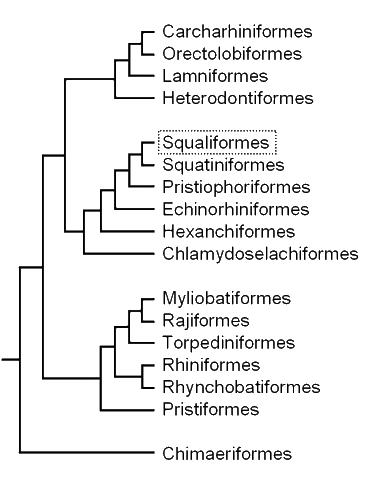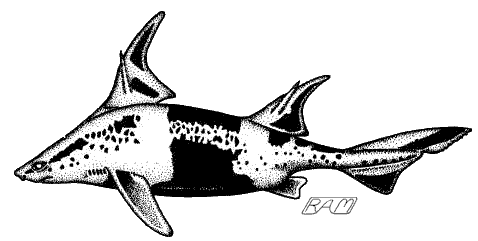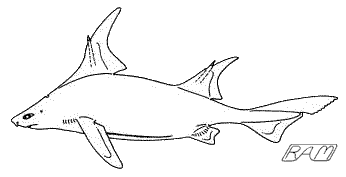Order Squaliformes:
Dogfish Sharks — 119 species

- five pairs of gill slits
- two dorsal fins, often with a spine along the leading edge; the first dorsal originates in front of pelvic fin origins
- lack of an anal fin
- many species are bioluminescent to some degree
- ovoviviparous
- exclusively marine; most species are strongly bottom oriented, although many mesopelagic forms undertake nightly vertical migrations; a successful and widely distributed group, dogfishes inhabit coastal and oceanic waters, mostly in cool temperate to deep tropical waters in both hemispheres, but ranging from the Antarctic to the Arctic
- 22 genera in 6 families

|
|
|
|
|
|
A representative squaloid, the Spiny Dogfish or "Spurdog" (Squalus acanthias) — probably the world's best known (if not most beloved) shark — showing the dorsal fin spines, transverse mouth, and lack of an anal fin characteristic of the group. Note that in the Spiny Dogfish and other members of the family Squalidae, there is no subterminal lobe (flap on the upper caudal lobe separated from the rest of the caudal fin by a notch) and the lower teeth are only slightly larger than the uppers. |
|
The squaliform sharks are creatures of extremes: in size they range from the puny to the downright gigantic, they inhabit a wide range of depths, from sundappled shallows to the chill blackness of the abyss, and their taxonomy is a veritable morass of contention and tentative revision. Many dogfishes are harvested commercially for food or pharmaceuticals. Beyond the basic parameters presented above, few generalizations can be made about this large and remarkably diverse group.
The squaloids include not only the smallest of sharks but also some of the very largest. Discovered in 1985 from a depth of 950 feet (290 metres) off the Caribbean coast of Colombia, the Dwarf Lanternshark (Etmopterus perryi) is probably the World's Smallest Living Shark (several diminutive squaloid species vie for this title, which is won by mere fractions of an inch). Males of this species mature at a length of about 6 inches (16 centimetres), females at about 7.5 inches (19 centimetres) — one of that size was found to contain three 2.5-inch (6-centimetre) embryos, each still bearing external gill filaments.
![]() Probably the world's smallest
species of shark, the Dwarf Lanternshark (Etmopterus perryi)
can be seen near life-sized (depending upon your monitor set-up) by
clicking on the small image. Males of
this species mature at a length of about 6 inches (16 centimetres),
females at about 7.5 inches (19 centimetres). This recently-discovered
species — just barely — dethrones the previous title holder, the Spined
Pygmy Shark (Squaliolus laticaudus), in which males mature at about
the same length as those of the Dwarf Lanternshark but females mature at a
slightly greater length, about 7.8 inches (20 centimetres). In any case,
since all sharks have a similar body plan and life history, 6 inches may
be close to the theoretical minimum size for adult sharks.
Probably the world's smallest
species of shark, the Dwarf Lanternshark (Etmopterus perryi)
can be seen near life-sized (depending upon your monitor set-up) by
clicking on the small image. Males of
this species mature at a length of about 6 inches (16 centimetres),
females at about 7.5 inches (19 centimetres). This recently-discovered
species — just barely — dethrones the previous title holder, the Spined
Pygmy Shark (Squaliolus laticaudus), in which males mature at about
the same length as those of the Dwarf Lanternshark but females mature at a
slightly greater length, about 7.8 inches (20 centimetres). In any case,
since all sharks have a similar body plan and life history, 6 inches may
be close to the theoretical minimum size for adult sharks.
On the opposite end of the squaloid size spectrum is the Greenland Shark (Somniosus microcephalus). Growing to a length of at least 21 feet (6.4 metres) — and possibly as long as 24 feet (7.3 metres) — the Greenland Shark rivals the infamous Great White (Carcharodon carcharias, a member of the order Lamniformes) for the distinction of largest predatory fish, if only in sheer dimension rather than reputation. Although it has long been maligned as being extremely sluggish, recent evidence suggests the Greenland Shark is an active and formidable predator, frequently taking fast-swimming fishes, marine mammals, and occasionally even large terrestrial animals such as caribou (known as reindeer in Europe).

Greenland Shark (Somniosus microcephalus)
The squaloids also include the record holder for greatest depth attained by any shark: the Portuguese Shark (Centroscymnus coelolepis) usually inhabits depths below 1,300 feet (400 metres) and has been caught as deep as 12,057 feet (3,675 metres). The familiar Spiny Dogfish (Squalus acanthias), which has been recorded at depths ranging from the surface down to at least 2,950 feet (900 metres), holds yet another distinction: it may be the most abundant species of shark, being the only one that supports fisheries of a size rivaling those of the more commercially important bony fishes. In a time of peak abundance between 1904 and 1905, an estimated 278 million Spiny Dogfish were taken off the coast of Massachusetts, USA, each year. The Spiny Dogfish is probably the best-known shark, particularly from a morphological, experimental, and fisheries biological standpoint — although its ecology and behavior are less well known than those of some other sharks. Female Spiny Dogfish reach sexual maturity at about 24 years of age, delivering up to 20 young after a gestation period of 18 to 24 months. An extremely long-lived species, the Spiny Dogfish is known to reach an age of at least 70 years.
 First dorsal fin
skeleton of the Spiny Dogfish (Squalus acanthias). The spine is actually a
highly modified dermal denticle and is supported by series of sturdy
cartilages. A similar arrangement occurs in the second dorsal fin,
although the spine is usually longer than on the first. The second dorsal
spine of this species has alternating bands of light and dark (each
representing a summer's and a winter's growth, respectively) that have
been used to estimate their owner's age. Although not venomous, dogfish
spines are often coated with a bacteria-rich mucus, which can land a
punctured fisherman in a sickbed for a week or two. Compare the
dogfish spine with that
of the Bullhead Sharks.
First dorsal fin
skeleton of the Spiny Dogfish (Squalus acanthias). The spine is actually a
highly modified dermal denticle and is supported by series of sturdy
cartilages. A similar arrangement occurs in the second dorsal fin,
although the spine is usually longer than on the first. The second dorsal
spine of this species has alternating bands of light and dark (each
representing a summer's and a winter's growth, respectively) that have
been used to estimate their owner's age. Although not venomous, dogfish
spines are often coated with a bacteria-rich mucus, which can land a
punctured fisherman in a sickbed for a week or two. Compare the
dogfish spine with that
of the Bullhead Sharks.
All squaloids are predators and opportunistic scavengers, but none has achieved the notoriety of the Cookie-cutter Shark (Isistius brasiliensis). Although it grows to a length of only 1.5 feet (50 centimetres), the Cookie-cutter is known to remove pieces from such large open-ocean creatures as yellowfin tuna, mahi mahi, wahoo, marlins and sailfishes, swordfish, Blue (Prionace glauca), Basking (Cetorhinus maximus) and Megamouth (Megachasma pelagios) sharks, elephant and fur seals, spinner, bottlenose, and Pacific spotted dolphins, and such large cetaceans as the beaked, humpback, pilot and sperm whales. The most brightly bioluminescent of all sharks, the Cookie-cutter acts like a pint-sized vampire: seducing its unsuspecting prey with its curious greenish glow, latching onto its prey with specialized suctorial lips and large, mobile basihyal ('tongue'), then using its bandsaw-like lower teeth to scoop out a conical plug of flesh. This procedure creates a characteristic 'crater wound', about 2 inches (5 centimetres) across and 2.5 inches (7 centimetres) deep; these wounds usually heal in about 2 to 3 months, eventually leaving a whitish, semi-circular scar. In July 1992, these little sharks left their crescentic bite marks on the body of a drowned fisherman off Oahu, Hawaii. Cookie-cutters have also bitten, and thereby damaged, oceanographic research equipment and — believe it or not — nuclear submarines. During the 1970's, several American subs were forced to return to base due to Cookie-cutter damage to their neoprene-covered sonar domes, which caused the sound-transmitting oil to leak out and rendered the enormous subs effectively 'blind'. This problem has since been circumvented by installing a protective fibreglass shield over the neoprene covering of the sonar domes. But the US Navy must have had nightmare visions of a completely unknown, rather diabolical, enemy weapon until this diminutive dogfish was revealed as the culprit.

The diminutive Cookie-cutter Shark (Isistius brasiliensis) grows to a length of about 1.5 feet (50 centimetres) and is brilliantly bioluminescent. It has short, powerful jaws armed with tiny, hook-like upper teeth and very sharp, bandsaw-like lower teeth. These lower teeth interlock, allowing them to be shed and replaced as a unit, ensuring that the shark has a continuous cutting edge at all times. The Cookie-cutter shark preys primarily on pelagic squids almost as large as itself, but also takes other free-swimming mesopelagic creatures, including bristlemouths and copepod-like crustaceans. It is most notorious, however, for cheekily scooping golfball-sized plugs of flesh from large open ocean fishes and cetaceans as well as damaging fishing, research, and naval equipment.
Perhaps the most unexpected and endearing expressions of squaloid diversity are the angular roughsharks (family Oxynotidae). These chubby, smallish — most are less than three feet (one metre) long — deep-water sharks feature oversized, prickly scales, a small mouth fringed with finger-like lip papillae, floppy, sail-like dorsal fins with deeply embedded spines, a triangular cross-section, and pronounced dermal ridges along the abdomen that resemble longitudinal 'love handles'. The oxynotids are so cute, they seem more like whimsical plush toys than real sharks. But real they undeniably are; a free-swimming Caribbean Roughshark (Oxynotus caribbaeus) was recently filmed in its natural habitat at a depth of 2,000 feet (600 metres) by a manned submarine at the bottom of a drop-off near the Bahama Islands. To see these mysterious squaloids alive and under their own power adds new dimension to one's appreciation of these animals, silently making their living in one of the last bastions of wilderness on our planet.

The Caribbean Roughshark (Oxynotus caribbaeus) is a little-known bottom dwelling inhabitant of the upper continental slopes off the Bahamas, Venezuela, and possibly elsewhere in the Caribbean Sea. It has been recorded from depths of 1,300 to 2,000 feet (400 to 600 metres), but may occur shallower or deeper. The largest known specimen is an adult male 19 inches (49 centimetres) long; the females of this species are believed to grow larger than the males (as is the common pattern in squaloids). Hidden away like pirates' treasure, this deep sea species has avoided the attention of commercial fisheries and was only recently observed and filmed alive.
Squaloid taxonomy has undergone major revision in recent years. One of the most radical of dogfish revisionists is Shigeru Shirai, whose taxonomic scheme offers many attractive features but remains highly controversial. Shirai divides the Squaloids into three orders (Squaliformes, Centrophoriformes, and Dalatiiformes), but I prefer to follow de Carvalho (1996) in adopting a somewhat watered-down version of Shirai's basic sequence of dogfish taxa. By this scheme, dogfishes represent a single order divided into six families.
Family Squalidae: Dogfish Sharks — 20 species
|
|
- smooth dorsal fin spines
- teeth in upper and lower jaws similar in size
- caudal peduncle with lateral keels; upper precaudal pit usually present
- caudal fin without subterminal notch
- includes spiny dogfishes (Squalus) and the Mandarin dogfishes (Cirrhigaleus)
Family Centrophoridae: Gulper Sharks — 15 species
|
|
- grooved dorsal fin spines
- teeth in the lower jaw conspicuously larger than in the upper
- lack of precaudal pits and lateral keels
- includes gulper sharks (Centrophorus) and birdbeak dogfishes (Deania)
Family Etmopteridae: Lantern Sharks — 51 species
|
|
- grooved dorsal fin spines
- photophores (luminous organs), distributed in specific patterns mainly on the ventral surface
- includes lantern sharks (Etmopterus), black (Centroscyllium) and Hooktooth (Aculeola) dogfishes
Family Oxynotidae: Angular Roughsharks — 5 species
|
|
- body high and compressed, triangular in cross-section, with a strong lateral keel along each side of the belly
- dorsal fins very high, each with a stout, deeply embedded spine
- denticles unusually large, giving the body an exceptionally rough texture
- includes only the roughsharks (Oxynotus)
Family Somniosidae: Sleeper Sharks — 18 species
|
|
- tiny grooved dorsal fin spines in most genera; spines lacking in Scymnodalatias and Somniosus
- both dorsal fins low and relatively small
- pectoral and pelvic fins relatively small, often with broadly rounded rear margin
- includes the Portuguese (Centroscymnus) and sleeper (Somniosus) sharks
Family Dalatiidae: Kitefin Sharks — 10 species
|
|
- dorsal fin spines lacking (except in Squaliolus laticaudus, which has a small spine on the first dorsal fin)
- eyes exceptionally large
- both dorsal fins relatively small (second dorsal base much longer than first in Euprotomicrus and Squaliolus)
- pectoral fins rounded and paddle-like; pelvic fins relatively small
- includes the kitefin (Dalatias), cookie-cutter (Isistius), pygmy (Euprotomicrus), and spined pygmy (Squaliolus) sharks; sometimes divided into 2 subfamilies, the Dalatiinae and Euprotomicrinae
Time and further research will tell whether Shirai's proposed revision — or some variation thereof — will gain widespread acceptance.








